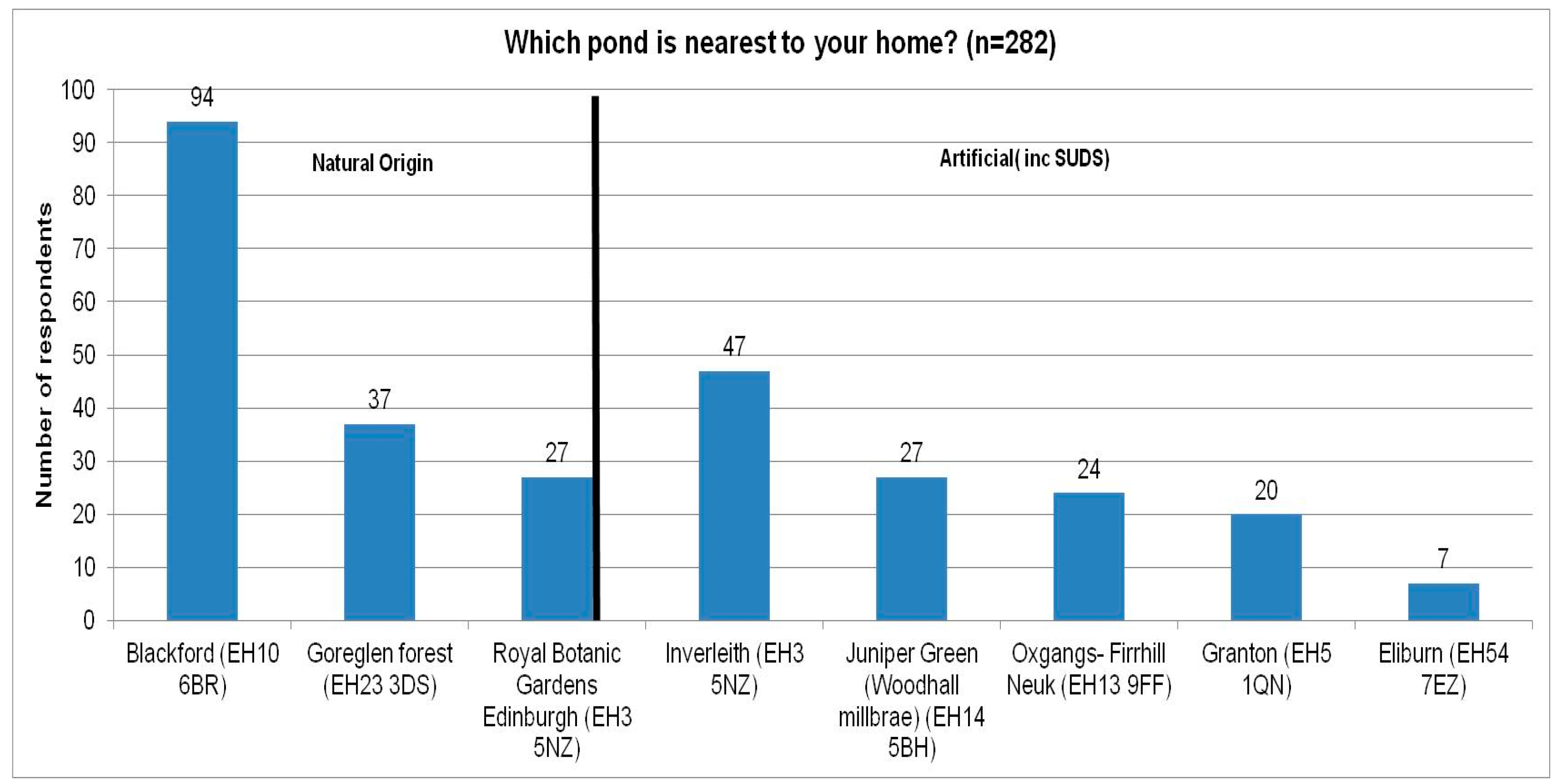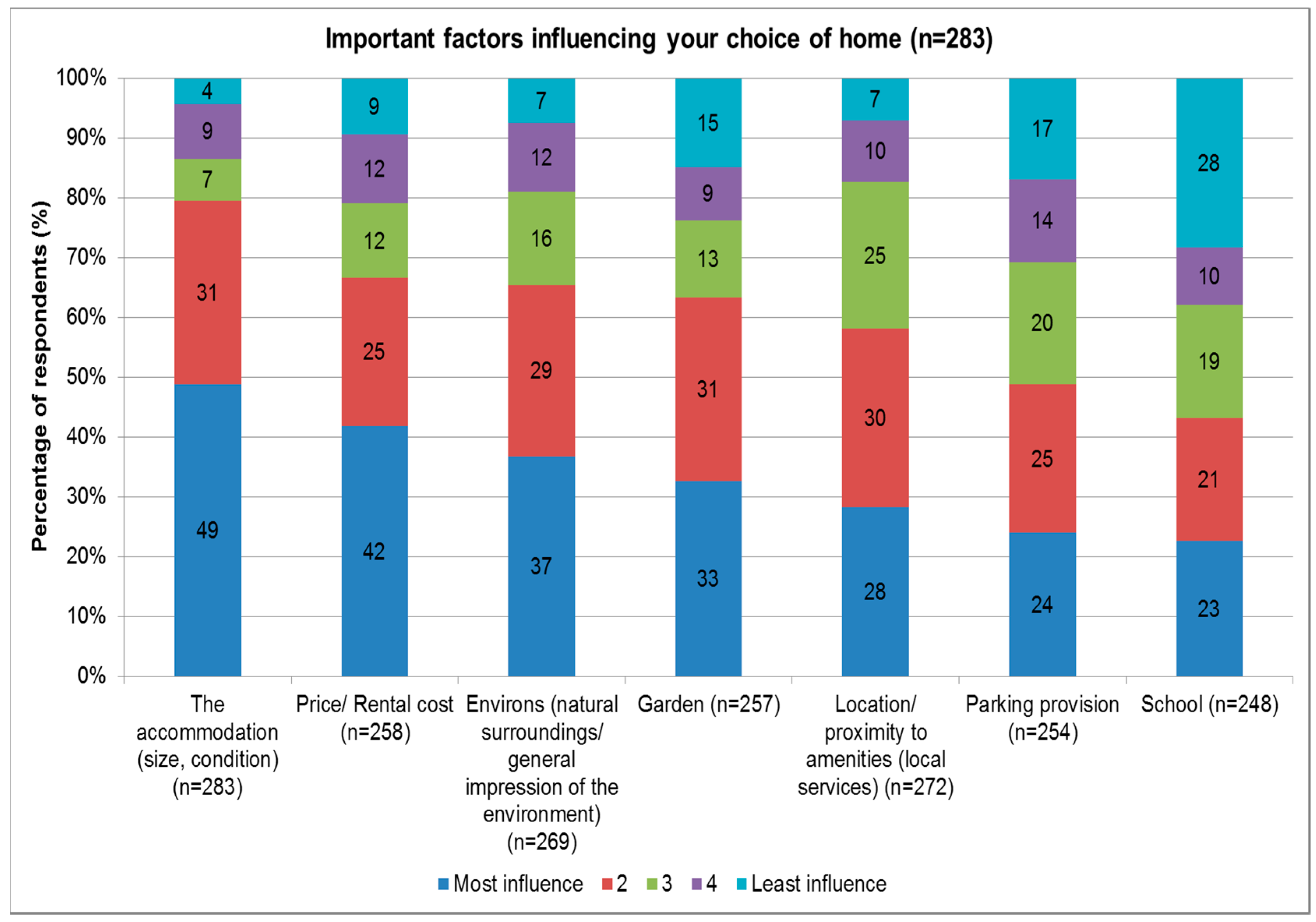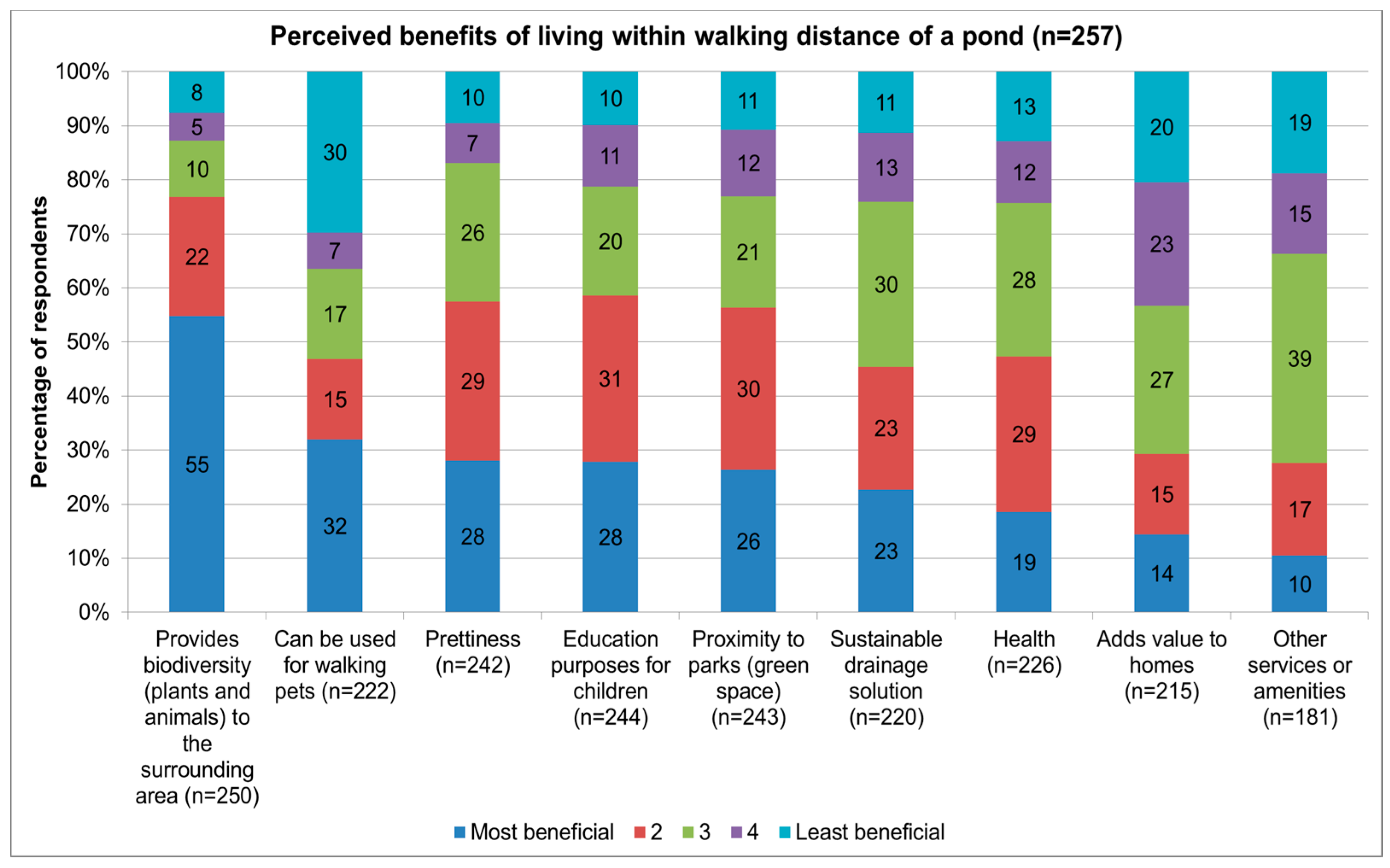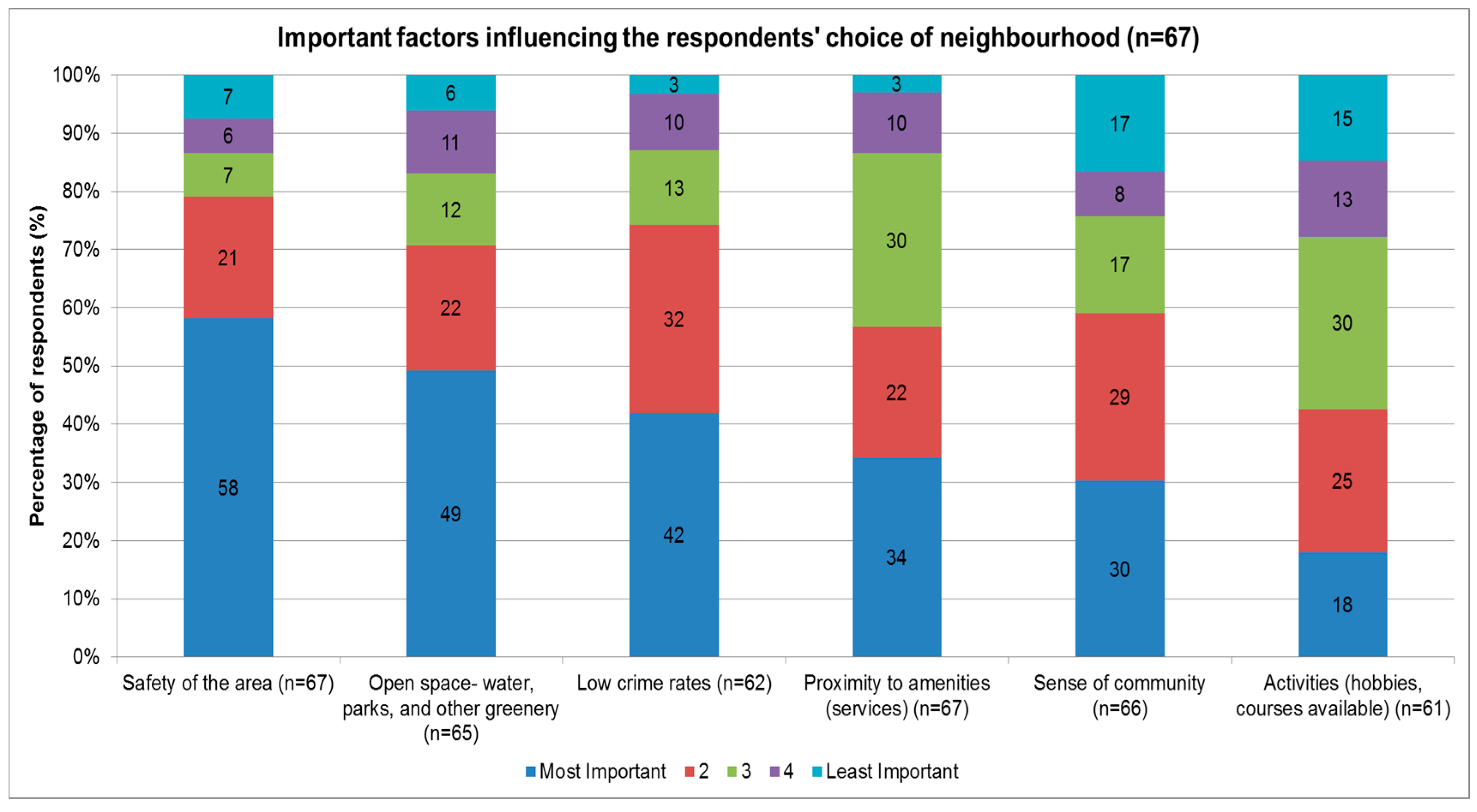Valuing Multiple Benefits, and the Public Perception of SUDS Ponds
Abstract
:1. Introduction
1.1. Artificial Ponds (Including SUDS)
1.2. Natural (Natural Origin) Ponds
1.3. Multiple Benefits Approach
1.4. Current Research
- What is the public perception of the potential benefits and disadvantages of living near a pond?
- How much value is placed on supporting habitat at their local pond (their Willingness to Pay for benefits), and are these values capable of offsetting costs?
2. Materials and Methods
2.1. Postal Survey Format
2.2. Postal Survey Pilot
2.3. Survey Administration
2.4. Development of an Online Survey
2.5. Post-Processing
2.6. Analytical Techniques
3. Results
3.1. Perceptions of Ponds and Characteristics Influencing Choice of Home
3.2. Safety Concerns
3.3. Biodiversity and Observations of Fauna and Flora at Their Local Pond
3.4. Value for Supporting Habitat
3.5. Offsetting Replacement Costs
4. Discussion
4.1. Public Perception
4.2. Valuation Discussion
5. Conclusions
Supplementary Materials
Acknowledgments
Author Contributions
Conflicts of Interest
Appendix A
| Pond | Inspection | Litter/Debris | Grass | Barrier Vegetation | Aquatic Vegetation | Desilting | OPEX |
|---|---|---|---|---|---|---|---|
| Juniper | £7203 | £219 | £0 | £3284 | £14,871 | £27,421 | £52,998 |
| Granton | £7203 | £10,948 | £21,320 | £164,221 | £743,556 | £672,464 | £1,619,712 |
| Eliburn | £7203 | £1528 | £2976 | £22,912 | £103,773 | £94,749 | £233,140 |
| Oxgangs | £7203 | £7389 | £14,389 | £110,835 | £501,839 | £459,938 | £1,101,592 |
| Inverleith | £7203 | £39,736 | £77,381 | £596,039 | £2,698,337 | £2,391,526 | £5,810,221 |
| Blackford | £7203 | £12,316 | £23,985 | £184,748 | £836,501 | £901,280 | £1,966,033 |
| Goreglen | £7203 | £456 | £888 | £6843 | £282,551 | £267,133 | £565,074 |
| Royal Botanics | £7203 | £4160 | £8102 | £62,404 | £30,982 | £45,944 | £158,794 |
References
- Biggs, J.; Williams, P.; Whitfield, M.; Nicolet, P.; Weatherby, A. 15 years of pond assessment in Britain: Results and lessons learned from the work of Pond Conservation. Aquat. Conserv. 2005, 15, 693–714. [Google Scholar] [CrossRef]
- Hill, M.J.; Ryves, D.B.; Wood, P.J. Macroinvertebrate diversity in urban and rural ponds: Implications for freshwater biodiversity conservation. Biol. Conserv. 2016, 201, 50–59. [Google Scholar] [CrossRef]
- Hassall, C.; Hill, M.; Gledhill, D.; Biggs, J. The ecology and management of urban pondscapes. In Urban Landscape Ecology: Science, Policy and Practice; Francis, R., Millington, J.D.A., Chadwick, M.A., Eds.; Routledge: Abingdon, UK, 2016. [Google Scholar]
- Construction Industry Research and Information Association (CIRIA). Construction Industry Research and Information Association (CIRIA). The philosophy of SuDS. In The SUDS Manual; Woods Ballard, B., Wilson, S., Udale-Clarke, H., Ilman, S., Scott, T., Ashley, R., Kellagher, R., Eds.; CIRIA: London, UK, 2015; Chapter 1. [Google Scholar]
- Lehsten, D.; von Asmuth, J.R.; Kleyer, M. Simulation of Water Level Fluctuations in Kettle Holes Using a Time Series Model. Wetlands 2011, 31, 511–520. [Google Scholar] [CrossRef]
- Williams, P.; Whitfield, M.; Biggs, J. How can we make new ponds biodiverse? A case study monitored over 7 years. Hydrobiologia 2008, 597, 137–148. [Google Scholar] [CrossRef]
- Lawson, E.; Thorne, C.; Wright, N.; Fenner, R.; Arthur, S.; Lamond, J.; Kilsby, C.; Mant, J.; Smith, L.; Ahilan, S.; et al. Evaluating the multiple benefits of a Blue-Green Vision for urban surface water management. In Proceedings of the UDG Autumn Conference and Exhibition, Chester, UK, 4–6 November 2015.
- Wade, R.; McClean, N. Multiple Benefits of Green Infrastructure. In Water Resources in the Built Environment: Management Issues and Solutions, 1st ed.; Booth, C.A., Charlesworth, S.M., Eds.; John Wiley and Sons: Chichester, UK, 2014; Chapter 24. [Google Scholar]
- Wolf, D.F.; Duffy, A.M.; Heal, K.V. Whole Life Costs of Sustainable Urban Drainage Systems in Dunfermline, Scotland. In Proceedings of the ASCE International Low Impact Development Conference, Houston, TX, USA, 19–21 January 2015.
- Wolf, D.F.; Duffy, A.M.; Heal, K.V. Whole Life Costs and Benefits of Sustainable Urban Drainage Systems in Dunfermline, Scotland. 2014; in draft. [Google Scholar]
- Jose, R.; Wade, R.; Jefferies, C. Smart SUDS: Recognising the multiple-benefit potential of sustainable surface water management systems. Water Sci. Technol. 2015, 71, 245–251. [Google Scholar] [CrossRef] [PubMed]
- Kelemen, E.; García-Llorente, M.; Pataki, G.; Martín-López, B.; Gómez-Baggethun, E. Non-monetary techniques for the valuation of ecosystem service. In OpenNESS Ecosystem Services Reference Book; Potschin, M., Jax, K., Eds.; EC FP7 Grant Agreement No. 308428; 2014; Available online: www.opennessproject.eu/library/reference-book (accessed on 15 November 2016).
- Arrow, K.; Solow, R.; Portney, P.R.; Leamer, E.E.; Radner, R.; Schuman, H. Report of the NOAA Panel on Contingent Valuation. 1993. Available online: http://www.economia.unimib.it/DATA/moduli/7_6067/materiale/noaa%20report.pdf (accessed on 25 November 2016).
- Whitehead, J.C. Plausible responsiveness to scope in contingent valuation. Ecol. Econ. 2016, 128, 17–22. [Google Scholar] [CrossRef]
- Hausman, J. Contingent Valuation: From Dubious to Hopeless. J. Econ. Perspect. 2012, 26, 43–56. [Google Scholar] [CrossRef]
- Bastien, N.R.P.; Arthur, S.; McLoughlin, M.J. Valuing amenity: Public perceptions of sustainable drainage systems ponds. Water Environ. J. 2012, 26, 19–29. [Google Scholar] [CrossRef]
- Briers, R.A. Invertebrate Communities and Environmental Conditions in a Series of Urban Drainage Ponds in Eastern Scotland: Implications for Biodiversity and Conservation Value of SUDS. Clean Soil Air Water 2014, 42, 193–200. [Google Scholar] [CrossRef]
- Hassall, C. The ecology and biodiversity of urban ponds. WIREs Water 2014, 1, 187–206. [Google Scholar] [CrossRef]
- Hill, M.J.; Mathers, K.L.; Wood, P.J. The aquatic macroinvertebrate biodiversity of urban ponds in a medium-sized European town (Loughborough, UK). Hydrobiologia 2015, 760, 225–238. [Google Scholar] [CrossRef] [Green Version]
- Scottish Government, Statistics Bulletin. Available online: http://www.scotlandscensus.gov.uk/statistical-bulletins (accessed on 22 September 2016).
- Chui, T.F.M.; Ngai, W.Y. Willingness to pay for sustainable drainage systems in a highly urbanised city: A contingent valuation study in Hong Kong. Water Environ. J. 2016, 30, 62–69. [Google Scholar] [CrossRef]
- Leggett, C.G.; Kleckner, N.S.; Boyle, K.J.; Duffield, J.W.; Mitchell, R.C. Social Desirability Bias in Contingent Valuation Surveys Administered Through In-Person Interviews. Land Econ. 2003, 79, 561–575. [Google Scholar] [CrossRef]
- Apostolaki, S. The Social Dimension of Stormwater Management Practices including Sustainable Urban Drainage Systems and River Management Options. Ph.D. Thesis, University of Abertay, Dundee, UK, 2006. [Google Scholar]
- Murdoch, M.; Baines Simon, A.; Anderson Polusny, M.; Bangerter, A.K.; Grill, J.P.; Noorbaloochi, S.; Partin, M.R. Impact of different privacy conditions and incentives on survey response rate, participant representativeness, and disclosure of sensitive information: A randomized controlled trial. BMC Med. Res. Methodol. 2014, 14, 90–100. [Google Scholar] [CrossRef] [PubMed]
- Verbic, M.; Slabe-Erker, R.; Klun, M. Contingent valuation of urban public space: A case study of Ljubljanica riverbanks. Land Use Policy 2016, 56, 58–67. [Google Scholar] [CrossRef]
- Duffy, A.; Jefferies, C.; Waddell, G.; Shanks, G.; Blackwood, D.J.; Watkins, A. A Cost Comparison of Traditional Drainage and SUDS. Water Sci. Technol. 2008, 57, 1451–1459. [Google Scholar] [CrossRef] [PubMed]
- Royal Haskoning: Costs and Benefits of Sustainable Drainage Systems (2012). Available online: https://www.theccc.org.uk/archive/aws/ASC/2012%20report/Royal%20Haskoning%20Costs%20and%20Benefit%20of%20SuDS%20Final%20Report.pdf (accessed on 15 October 2016).
- HM Treasury. The Green Book: Appraisal and Evaluation in Central Government. 2013. Available online: https://www.gov.uk/government/uploads/system/uploads/attachment_data/file/220541/green_book_complete.pdf (accessed on 19 October 2016). [Google Scholar]
- E-Spatial. Available online: https://www.espatial.com/ (accessed on 21 October 2016).
- Scottish Index of Multiple Deprivation (SIMD): 2016 Report. Available online: http://www.gov.scot/simd (accessed on 15 November 2016).
- American Association of Public Opinion Research: Response Rate Calculator. Available online: http://www.aapor.org/Education-Resources/For-Researchers/Poll-Survey-FAQ/Response-Rates-An-Overview.aspx (accessed on 10 September 2016).
- Owusu, S.; Wright, G.; Arthur, S. Public attitudes towards flooding and property-level flood protection measures. Nat. Hazards 2015, 77, 1963–1978. [Google Scholar] [CrossRef]
- Finlay, J.; Franke, T.; McKay, H.; Sims-Gould, J. Therapeutic landscapes and wellbeing in later life: Impacts of blue and green spaces for older adults. Health Place 2015, 34, 97–106. [Google Scholar] [CrossRef] [PubMed]
- Teedon, P.; Gillespie, M.; Lindsay, K.; Baker, K. Parental Perceptions of the Impacts the Built Environment Has on Young Children’s Health: A Qualitative Examination and Lay Assessment Amongst Residents in Four Scottish Communities. Health Place 2014, 28, 50–57. [Google Scholar] [CrossRef] [PubMed]






| Case Study | Setting of Pond | Use of Pond | Surface Area (m2) | Date Established | Ownership | Population within 500 m Radius | SIMD Decile Score |
|---|---|---|---|---|---|---|---|
| Granton Pond, Edinburgh | In a park. Near a supermarket and college. | Drainage (SUDS) pond. Provides amenity and biodiversity. | 12,000 | 2005 | Private—Capita Symonds/National Grid | 2315 | 3 |
| Juniper Green Pond, Edinburgh | Residential area. Near the Water of Leith footpath. | Drainage (SUDS) pond, focal point from flats. | 240 | 2005 | Private—James Gibb | 1459 | 10 |
| Oxgangs, Edinburgh | Residential area. | Drainage (SUDS) pond and amenity | 8099 | 2007–2010 | Private—Dunedin Canmore | 3796 | 2 |
| Eliburn, Livingston | Residential area. Near light industrial units | Drainage pond (SUDS)—not accessible to public | 1675 | 2007–2011 | Private—Gladmans | 364 | 9 |
| Blackford, Edinburgh | Local Nature Reserve | Biodiversity and amenity | 13,500 | 1800–1900 | Public—Edinburgh Local authority | 847 | 9 |
| Goreglen, Mid Lothian | Woodland setting. Near main road. | No use currently. Flood plain | 500 | 1794–1861 | Public—Midlothian Ranger Service | 39 | 4 |
| Royal Botanic Gardens, Edinburgh | Former estate. Near residential area. | Amenity and education. Outflow pipe to Water of Leith. Feeding wildfowl. | 4560 | 1880 | Private | 2312 | 10 |
| Inverleith Pond, Edinburgh | Park setting. Near residential area. | Model boat activities, recreation, and feeding wild fowl | 43,554 | 1870 | Public—Edinburgh Local authority | 804 | 10 |
| Pond Name | Supports Plants (£) | Supports Mammals (£) | Supports Fish (£) | Creates Habitat for Birds (£) | Supports Invertebrates (£) | Total (£) |
|---|---|---|---|---|---|---|
| Granton (n = 19) | 0.53 | 0.53 | 0.53 | 0.58 | 0.42 | 2.58 |
| Juniper Green (n = 22) | 1.09 | 1.09 | 1.32 | 1.09 | 1.09 | 5.68 |
| Oxgangs (n = 23) | 2.87 | 2.78 | 2.96 | 2.96 | 2.91 | 14.48 |
| Eliburn (n = 2) | 5.50 | 3.00 | 3.00 | 5.50 | 7.50 | 24.50 |
| Blackford (n = 78) | 2.40 | 2.47 | 2.53 | 3.03 | 2.09 | 12.51 |
| Goreglen (n = 22) | 1.73 | 1.86 | 1.91 | 2.00 | 1.73 | 9.23 |
| Royal Botanic (n = 21) | 3.71 | 2.76 | 2.71 | 3.48 | 2.33 | 15.00 |
| Inverleith (n = 45) | 2.40 | 2.33 | 2.42 | 2.64 | 2.47 | 12.27 |
| Totals (£): | 20.23 | 16.82 | 17.38 | 21.28 | 20.54 | 96.25 |
| Pond Name | Number of Households | Total Population | Monthly Value (£) | Annual Value (£) |
|---|---|---|---|---|
| Granton | 1016 | 2315 | £5973 | £71,672 |
| Juniper Green | 606 | 1459 | £8290 | £99,475 |
| Oxgangs | 1840 | 3796 | £54,966 | £659,593 |
| Eliburn | 108 | 364 | £8918 | £107,016 |
| Blackford | 847 | 1988 | £24,870 | £298,439 |
| Goreglen | 14 | 39 | £360 | £4320 |
| Royal Botanic | 1161 | 2312 | £34,680 | £416,160 |
| Inverleith | 399 | 804 | £9865 | £118,380 |
| Total | 5991 | 13,077 | £148,921 | £1,775,055 |
| Pond Name | NPV Benefits | NPV OPEX Costs | CAPEX Costs | Balance |
|---|---|---|---|---|
| Granton | £1,720,765 | £1,619,712 | £990,000 | −£888,946 |
| Juniper Green | £2,388,284 | £52,988 | £13,200 | £2,322,086 |
| Oxgangs | £15,836,096 | £1,101,592 | £668,167 | £14,066,337 |
| Eliburn | £2,569,335 | £233,140 | £115,156 | £2,221,039 |
| Blackford | £7,165,189 | £1,966,033 | £1,336,500 | £3,862,656 |
| Goreglen | £103,718 | £92,315 | £41,250 | −£29,847 |
| Royal Botanic Gardens | £9,991,540 | £631,553 | £376,200 | £8,983,787 |
| Inverleith | £2,842,172 | £5,810,221 | £3,593,205 | −£6,561,254 |
| Total | £42,617,101 | £11,507,564 | £7,133,678 | £23,975,859 |
| Per Population | £3258.94 | £879.99 | £545.51 | £1833.44 |
© 2017 by the authors. Licensee MDPI, Basel, Switzerland. This article is an open access article distributed under the terms and conditions of the Creative Commons Attribution (CC BY) license ( http://creativecommons.org/licenses/by/4.0/).
Share and Cite
Jarvie, J.; Arthur, S.; Beevers, L. Valuing Multiple Benefits, and the Public Perception of SUDS Ponds. Water 2017, 9, 128. https://doi.org/10.3390/w9020128
Jarvie J, Arthur S, Beevers L. Valuing Multiple Benefits, and the Public Perception of SUDS Ponds. Water. 2017; 9(2):128. https://doi.org/10.3390/w9020128
Chicago/Turabian StyleJarvie, Joy, Scott Arthur, and Lindsay Beevers. 2017. "Valuing Multiple Benefits, and the Public Perception of SUDS Ponds" Water 9, no. 2: 128. https://doi.org/10.3390/w9020128





